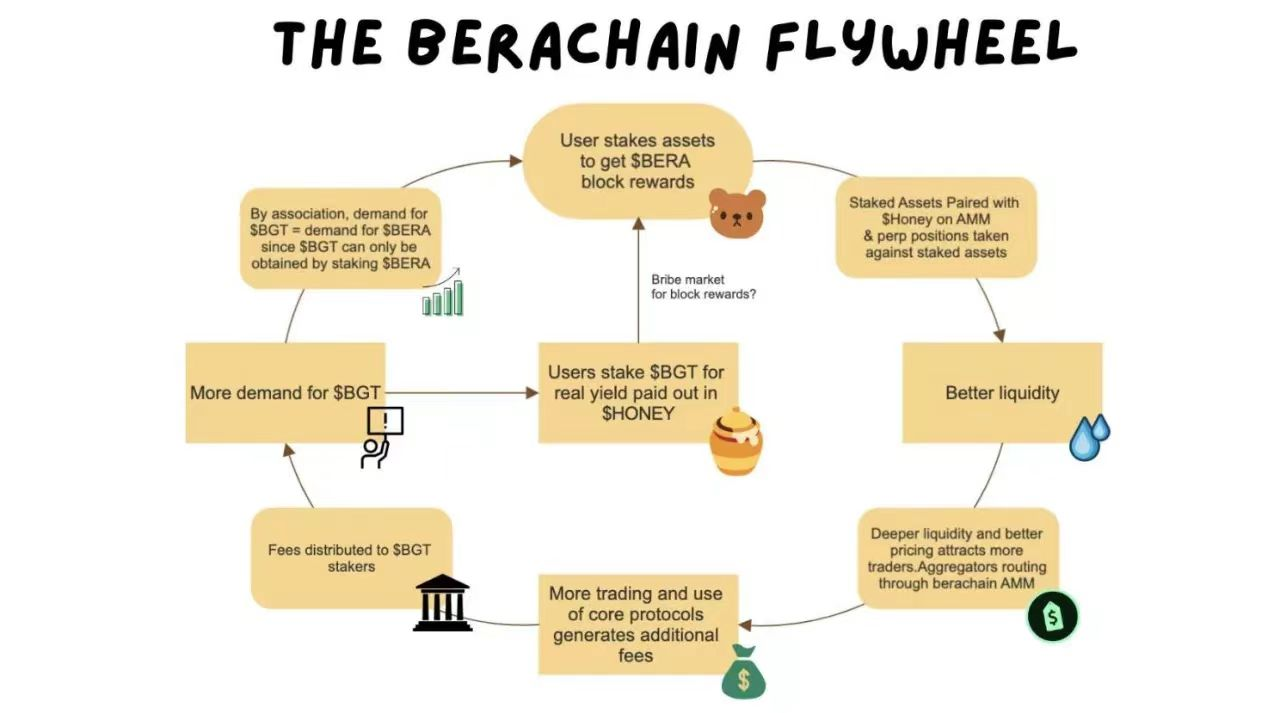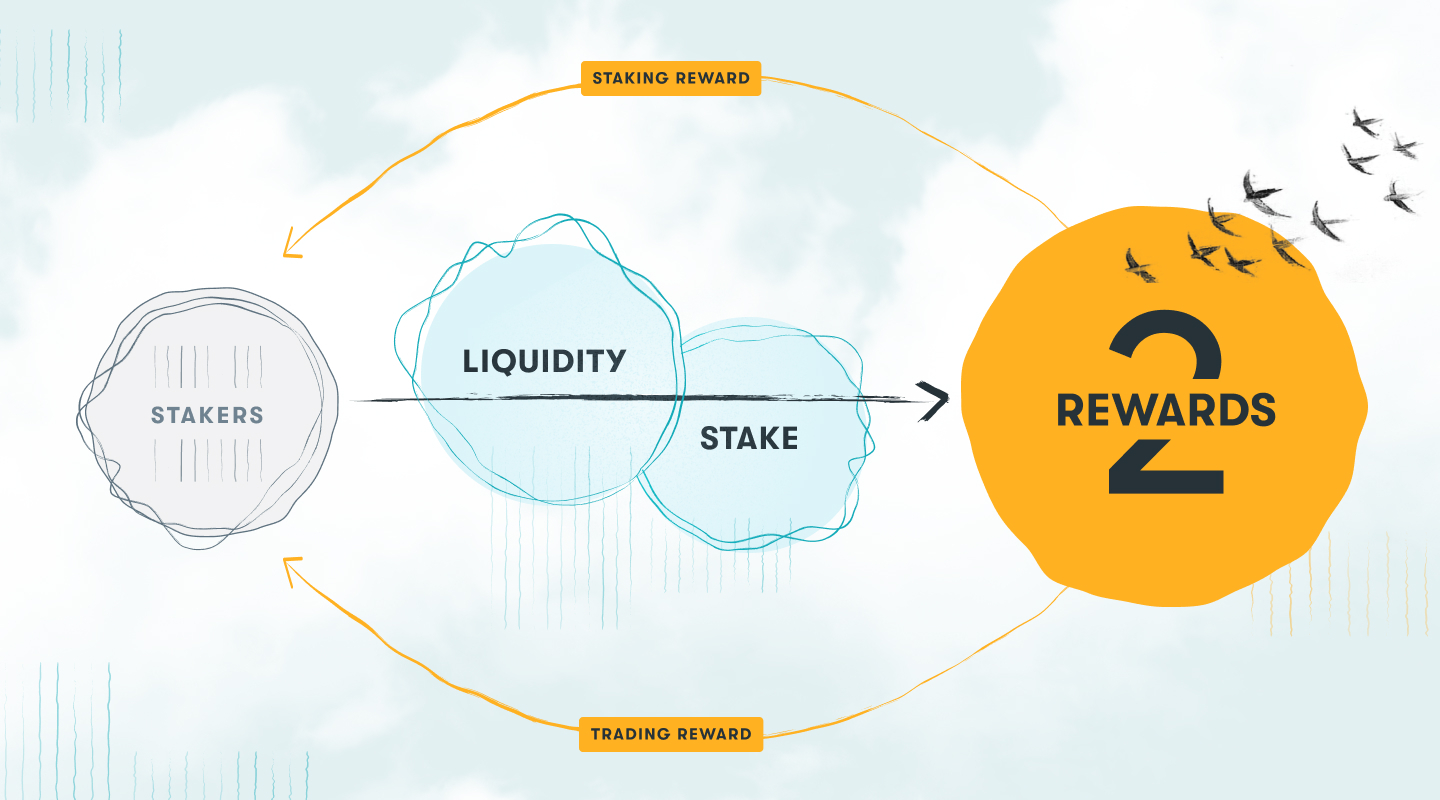浅谈流动性与PoS如何有效结合?以Berachain、Tenet、Mangate为例
PoS 机制在保护公链安全性的同时也占用了大量资金,导致这些资金利用率低下。而 DeFi 也常常被人诟病,流动性没有忠诚度,项目容易陷入死亡螺旋。如何将这两者结合,让流动性能够在获得收益的同时,参与到保护公链的安全?Berachain、Tenet、Mangate 等项目在这方面做了尝试,PANews 将在本文中做简要探讨。
Berachain:流动性证明与三代币模型
Berachain 是一个使用 Cosmos SDK 构建的 EVM 兼容链,它采用了一种独特的“流动性证明”共识机制和三代币模型。Berachain 希望以一种更可持续的方式来激励生态系统,流动性证明共识促进 Berachain 的流动性、资产利用率与市值的同步增长。
Berachain 中的三种代币分别为:原生稳定币$HONEY、Gas 代币$BERA、治理代币$BGT。之所以将 Gas 代币和治理代币分开,是为了避免网络中的频繁使用者的投票权随着时间的推移而减少。
用户将各种资产存入 Berachain 的共识系统中,以获得参与共识的权利,并分享交易费用、协议费用和区块奖励$BERA。用户存入的资产会用于和新铸造的稳定币$HONEY 在 AMM 中提供流动性,铸造$HONEY 的抵押品即为用户存入的资产,如果因为 AMM 中的无常损失等原因导致损失,用户最终能够赎回的资产数量也可能减少。$BERA 除了用于支付 Gas 费之外,还可以用于质押以获得治理代币$BGT,这也是产生$BGT 的唯一渠道。
质押$BGT 可以获得 AMM 中的交易手续费等协议收入的分成。那么,Berachain 的飞轮可能如下。

用户质押资产以获得$BERA 区块奖励,质押的资产和$HONEY 在 AMM 中组成交易对;
质押的资产越多,协议的流动性就越好,也更能吸引交易量;
交易量越多,产生的协议收入就越多,对$BGT 的需求就越高;
由于$BGT 只能通过质押$BERA 产生,对$BGT 的需求导致对$BERA 的需求升高;
激励用户质押更多资产以获得$BERA。
目前 Berachain 主网还未上线,具体表现还需等待项目上线。今年 4 月,该项目以 4.2 亿美元的估值获得了 Polychain Capital、Hack VC、OKX Ventures 等的投资。
Tenet:多元化权益证明与流动性质押
Tenet 也是一个基于 Cosmos SDK 构建的 EVM 兼容链,它引入了一种新的权益证明框架——多元化权益证明(DiPoS),相比于传统的 PoS 模型提高了安全性。
在去中心化应用中,治理攻击的安全事件时有发生,对应到 Layer 1 区块链中就是网络攻击。多元化权益证明允许持有一篮子资产的用户作为验证者参与网络共识,这就消除了网络被某一持有大量单一资产(公链原生代币)的用户所控制的风险。

Tenet 的共识可以批准除原生代币之外的资产参与网络安全,如 ETH、ATOM、BNB、MATIC、ADA 和 DOT。随着资产种类的增多,网络攻击者需要在这些主流加密资产中拥有显著的份额才能完成攻击,也就受益于这些资产所带来的联合安全性。
为了在维护自身网络安全的情况下帮助用户获得收益,Tenet 也接受 Lido、RocketPool 等协议,以及 Binance 和 Coinbase 等机构铸造的流动性质押衍生品。同时,Tenet 还提供自己的内部基础设施,帮助 ETH、ATOM 等资产完成流动性质押。由于 Tenet 更在乎的是网络的安全性,那么 Tenet 可以不像 Lido 等协议一样收取 10% 的管理费,也就使自己的流动性质押服务更有吸引力。
通过这种跨链质押方式,Tenet 希望创造一个多方互利的合作关系,其它链可以通过更多的质押量增加安全性,用户有了更多的收益机会,Tenet 自身也受益于多元化证明所带来的安全性提升。
目前,Tenet 已上线主网 Beta 版本,原生代币$TENET 也已在近期上线 Bybit、Kucoin 等交易所。在 Tenet 的系统中,同样有原生稳定币和 DEX。
Mangate Finance:采用流动性证明的 DEX 应用链
Mangate 是 Polkadot 生态中的一个跨链去中心化交易所,赢得了 Kusama 第 68 次平行链插槽拍卖。
Mangate 认为 PoS 锁定了大量资产,这就导致 DeFi 中的可用资金减少,同时质押资金的效率较低。因此,它引入了流动性证明机制,使用 LP 代币作为质押资产来释放质押的流动性,从而提高资本效益。

Mangate 也是 DEX 应用链的一个案例,与传统 DEX 相比,它有一些优点:交易中没有 Gas 费,但需支付 0.3% 的交易手续费;在共识层面防止 MEV;采用流动性证明机制,质押 LP 代币可以同时获得区块奖励和提供流动性的手续费收益。
在今年 6 月份升级后,Mangate 在流动性证明上启用了原生代币$MGX 的单币质押,扩大了$MGX 的使用范围,也加强了网络的安全性。
Mangate 已在 Kusama 上发行原生代币$MGX,但在 Kusama 上使用者较少。项目仍在进行着更新,计划在以太坊的 Layer 2 上构建新的 ZK Rollup。
小结
在以上方案中,Berachain 希望流动性能够更加可持续,并与代币模型组成一个流动性与代币需求之间相互促进的飞轮;Tenet 希望利用其它 PoS 代币来增加自己的网络安全性;Mangate 以 LP 代币作为质押资产释放质押的流动性。
这些改进的 PoS 方案能够增加资本效率,在获得区块奖励的同时,获得 DEX 的交易手续费奖励以及其它区块链的区块奖励等,增加了 PoS 资产的用途。但近期热门的 LSD 与 LSDFi 也是其竞争赛道,也让 PoS 资产在维护网络安全、获得质押收益、保持资产流动性性的同时能在 DeFi 活动中获得额外收益。
另外,这些改进方案让更多种类的资产可以参与到区块链的共识中来,在项目增长时,确实可以因为支持的资产种类多,吸引更多有价值的资产,从而提高网络的安全性。但如果发生死亡螺旋,在传统 PoS 链中,要对网络进行攻击,必须持有公链的原生代币。而在 Tenet 这样的方案中,持有主流币的大户同样有可能对网络发起攻击,有利也有弊。



